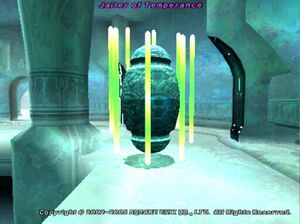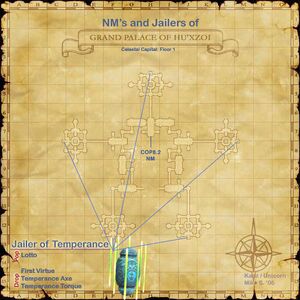Jailer of Temperance
| Zone | Level | Drops | Steal | Spawns | Notes |
|---|---|---|---|---|---|
| Grand Palace of Hu'Xzoi | 85 | 5 | A, T(S) ??? HP | ||
|
HP = Detects Low HP; M = Detects Magic; Sc = Follows by Scent; T(S) = True-sight; T(H) = True-hearing JA = Detects job abilities; WS = Detects weaponskills; Z(D) = Asleep in Daytime; Z(N) = Asleep at Nighttime; A(R) = Aggressive to Reive participants | |||||
Notes
- Pops 3-5 seconds after killing the Eo'zdei placeholders that spawn in the small rooms with alcoves in (H-4), (C-8), (L-8), (J-13), and (F-13) of the upper (entrance) level of Grand Palace of Hu'Xzoi.
- The placeholder changes (presumably every 15 minutes). In other words, systematically moving from placeholder to placeholder, killing each one will not allow you to eventually narrow down which one is the holder for the Jailer of Temperance.
- Eo'zdei placeholders respawn every 16 minutes.
- 150% movement speed.
- Immune to direct magic damage (i.e. nukes) and all but one type of physical damage at a time. Because of this, damage dealers with multiple damage types are very useful for this fight.
- With rings out, only vulnerable to Slashing damage.
- With poles out, only vulnerable to Piercing damage.
- With nothing out, only vulnerable to Blunt damage.
- A Monk swapping between Destroyers/Hades Sainti, Vampiric Claws and Birdbanes is able to deal damage consistently throughout the fight.
- DoT is very effective. Keep Bio III, Poison II or Disseverment poison and Shock/Choke/Burn or Rasp/Drown/Frost on at all times.
- The Corsair ability Quick Draw circumvents these damage mechanics, and will deal normal damage.
- Tomahawk allows all damage types to hurt the Jailer, including magic.
- Uses Meikyo Shisui multiple times.
- Like other Zdei, its TP moves depend on whether it has rings out, poles out, or nothing out.
- Most dangerous in Blunt mode, when it can use Meikyo Shisui + Optic Induration to petrify most of the alliance.
- Optic Induration resets hate.
- Susceptible to Gravity, Flash and Shadowbind, immune to Blind, Slow, Paralyze, Elegy, Stun, Bind and Requiem.
- It will despawn if it remains idle for 2 minutes.
- It is possible to win this fight with a party of 6, though it does take some time. A Paladin tank and two healers are a must, with the other three members being melee. Jobs that can use several different damage types are recommended.
Historical Background
The Heavenly Virtues
The 7 Jailers of Sea are based on the 7 Virtues. Virtue is defined as moral excellence. Virtue can accordingly be characterized as having desirable character traits, traits which direct a person to act in accord with the best possible standard. In other words, Virtues improve us towards the idealized perfection of our being. In order to be virtuous, one must continuously have virtues as habits of their character. The idea of Virtues originate with the ancient Greeks and the idea was later picked up and made a part of Christian moral theology, probably during the Medieval era. There are 2 sets of virtue: the cardinal virtues (sometimes called the classical virtues) & the theological virtues. The former originate with the ancient Greeks and the latter originates in the Bible (New Testament), specifically 1 Corinthians 13, but became popular in Medieval Christianity. The cardinal virtues are: Prudence/Wisdom, Justice, Fortitude/Courage, Temperance. The theological virtues are: Faith, Hope, Charity/Love. Together, these seven virtues were called the Heavenly Virtues or simply the Seven Virtues. The pairing of these seven virtues appeared to have originated with 13th century Christian philosopher Thomas Aquinas in his work "Summa Theologica". They became a popular element for depiction in the Medieval and Renaissance periods.
According to ancient Greek philosophy, they viewed each Virtue as being the mean on a spectrum of some characteristic. As such, each Virtue would have 2 vices associated with it, lying at the extremes of that spectrum. Note that the Virtue was the mean, not necessarily the median between both vices. According to Medieval Christian thought, these virtues are said to improve one's love of God and Man. The cardinal virtues are dispositions of one's being which govern one's actions, restrain their passions and guide their conduct in accordance with reason. The theological virtues are said to give Christians the ability to live in a relationship with the Holy Trinity. They are considered to give life to all the moral virtues (the cardinal and theological virtues). The Heavenly Virtues are generally limited to the Roman Catholic denomination of Christianity. It should be noted the Chinese, Muslim, and other cultures have different sets of virtues.
The seven Heavenly Virtues do not align up with the Seven Deadly Sins. The seven Holy Virtues (or Contrary Virtues) do though, which are: Humility (counters Pride), Kindness (counters Envy), Patience (counters Wrath), Abstinence (counters Gluttony), Chastity (counters Lust), Liberality (counters Greed), Diligence (counters Sloth).
The Virtue of Temperance
Temperance (Temperantia) is one of the Virtues. It is a cardinal virtue which originated with the ancient Greeks and was adopted by Christianity. Temperance is the practice of moderation and self-restraint with regard to one's behavior and actions.
Temperance (Sophrosyne/Sophrosune) was the ability of self-control, of self-restraint. Self-discipline and moderation are manifestations of Temperance. Temperance was the mean between over-indulgence/hedonism (gluttony, drunkenness, liciviousness) and under-indulgence/asceticism (denial of basic desires, includes mortification of the flesh, self-deprivation, starvation). While the other parts of the soul in Greek culture had an associated virtue which arose from the best characteristics of them, the desiring/animal part of the soul (which was represented as a monster) had no virtue which arose from it. Temperance was considered the virtue created when reason tamed this part of the soul. In other words, the animal part of the soul has no redeeming characteristics and Temperance was the virtue created when all 3 parts of the soul (the rational part, the passionate part, and the desiring part) are in harmony. To Medieval and Renaissance-era Christians, Temperance was the Virtue which moderated one's pursuit of pleasures. It gave will-power the strength to hold the body's instincts and appetites in check and sets up limits for behavior. They believed Temperance was accompanied by the gifts of honesty, abstinence, sobriety, chastity and would challenge the sins of pride, wrath, gluttony, and lust, as well as the vices of immodesty and curiosity.
In Medieval and Renaissance art, Temperance is frequently depicted as a calm-expressioned woman holding two identical ampullae (a type of vase popular around the Mediterranean in antiquity) and is engaged in pouring liquid from one into the other. The ampullae are occasionally depicted as chalices or mainland European water jugs. In some later depictions, Temperance was shown holding reins. Given the frequent depiction of Temperance with vases, it is logical Square-Enix chose a Zdei mob to be the Jailer of Temperance.
The Jailers of Sea
It is not clear what the proper context of the Jailers is. "Jailer of (Virtue)" can be taken two ways. First, it can imply they are the Jailer of (Virtue), imprisoning that Virtue (or more specifically, imprisoning one aspect of Absolute Virtue). This would mean they do not possess the Virtue, they jail it. Second, it can imply they are the Jailer of (Virtue), being a jailer possessing that virtue. This would mean they are a jailer which possesses the Virtue in question. In this case, they would not be jailing the Virtue in their name, they would be jailing the monster known as Absolute Virtue. The latter interpretation is more logical since each Jailer drops a weapon and a torque bearing their namesake Virtue. If they were to be jailing the Virtue in question, it would make more sense for them to drop weapons and torques not named after the virtue, like objects named after the 7 Vices or the 7 Sins. Since the title you gain for defeating Absolute Virtue is "Virtuous Saint," this is the more widely accepted context. However, the former also makes sense because if the jailer is defeated, the virtue it was imprisoning is released. Absolute Virtue, interestingly, appears to drop 7 items named after synonyms for the deadly sins. It may drop these sins because upon defeating Absolute Virtue you theoretically destroy all the virtues, leaving the only thing left to gain to be sins. It is also possible that the sins are the "chains" placed on Absolute Virtue.
* Sin of Indignation (wrath) * Sin of Insolence (pride) * Sin of Indulgence (greed) * Sin of Infatuation (lust) * Sin of Indolence (sloth) * Sin of Invidiousness (envy) * Sin of Intemperance (gluttony)


